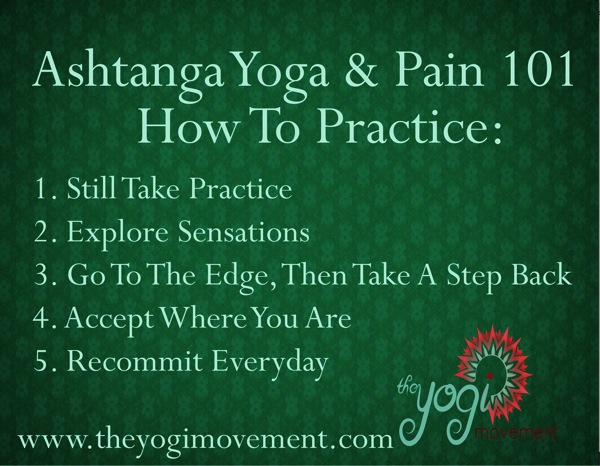I know I know, I’m sick of seeing articles about yoga and pain too! It seems like everyone has a strong opinion on how to practice when you’re feeling pain in yoga practice.
Some teachers say that you should never feel pain and to rest, and others say pain is normal and to continue practice. I’m sure this has to do with everyone’s experience with pain, and what their teacher taught them.
You guessed it. I’m going to tell you my opinion right now…
This year, I have been experiencing on and off shoulder pain, and I have had to drastically modify my practice when the pain flares up. It’s not just a little pinch or discomfort, but this pain gets so bad that it hurts for me to fully lift my arms.
I haven’t been able to do jump backs. Sometimes I have to drop to my knees in Chaturanga. If it’s a really bad day, Marichyasana D just isn’t happening.
For the most part, it doesn’t get that bad, but last week it became so painful on my right side that I couldn’t do the internal shoulder rotation that comes with Marichyasana D. As I’ve been practicing with compassion and exploring my emotional state, the pain is nearly gone a week later.
I’m a big advocate for still taking practice when feeling pain, but compassionately, and being open to changing or modifying postures.
When I explore sensations in the body, there is always a lesson to go with it, and as I let go, the pain eventually leaves my body. All pain is sensation and energy in the body, and these feelings are related to everything we’ve ever experienced and continue to experience. I have come to understand this because I’ve experienced it in my mind and body, and since I have felt many changes through the practice, I can work with different sensations in the body.
Below is a guide on how I have learned to work with the discomfort. I hope it provides some insight!
1. Should I Still Practice?
Yes! This is SO important! You could tell me all day what you’re feeling, but you are the only one that really knows what’s happening internally. This is why I think it’s SO important to continue practice because this where you will really get into the subtle sensations of the body and mind. These sensations are not just going to work with you on a physical level, but really test your mindfulness and compassion towards yourself.
This might mean complete modifications of postures, or even sitting in meditation position. It might mean that you just do Surya Namaskara. Either way, you’re still practicing.
Quick Note: If you have an injury and your doctor tells you not to practice, always follow your doctors advice first.
2. Explore The Sensations
What are you feeling? Is it Pain? Is it Discomfort? Is it Sensation?
I think one of the biggest reasons that this is such a controversial subject is that it’s completely personal. What you might be feeling as pain might feel like discomfort to me. What feels good to you might feel bad to me. When my students tell me they feel pain, I try to ask a lot of questions to try to gauge how intense it is and where they’re feeling it.
Is it the muscle, the joint, is it scar tissue? That way, I can work with them on how to make the practice and postures work for them during this time, and also guide them on exploring the sensations in the body.
3. Go to the edge, and then take a step back
When I attended a workshop with Greg Nardi, he said to go to the point of discomfort, then take a step back, and explore the sensation. He said that if you’re not sure what it is, to stop there. Explore further each day.
When practicing with intense sensation, still do your regular practice, but to slow things down, and be aware and mindful of any sensation that comes up in the mind and body. When you get to the point of pain, take a step back, and explore what you’re feeling.
Don’t push yourself into pain, or create pain. Any future pain that you know of should be prevented and avoided (Yoga Sutra 2.16). However, at the same time, when pain comes up beyond our control, we need explore it, and work through the pain and emotions as a way of purification (Yoga Sutra 2.1). In order to find this balance, we can take advantage of this great opportunity to explore how you can make any asana a steady and comfortable posture (Yoga Sutra 2.46). See how I did that??!!
If you push ahead mindlessly, without using your awareness, you’re bound to make things worse and create an injury. If you work with breath and awareness, you’ll be able to discover where this feeling is coming from, and how to work with it so you can heal.
Sometimes, when I’m exploring the discomfort, I realize that what I’m feeling is an impression of pain created by the mind. Practicing gives me the tools to see through this illusion, and remove or change this impression. If we can do that on the mat, then we can learn to break through the illusion of suffering off of the mat!
4. Accept Where You Are – This Is Real Progression In Practice
When you take practice with pain or an injury, accept where you are. The term “full practice” is a little misleading, and I think Richard Freeman puts it best when he says:
“You can still practice, but you might have to modify your definition of what Ashtanga yoga is. Depending on the injury you might have to skip or modify particular postures or sets of postures, but still you can cultivate gazing, bandhas, perhaps pranayama, and intelligent dialectical movement in whatever postures you are able to do. If you are lying in a full body cast, you can still practice mindfulness and discriminating awareness which are the essential underpinnings of Ashtanga yoga.”
Go in with the intention of doing your practice, but if you are only able to do a sun salutation, or just a forward bend, then maybe that is your full practice? Explore what happened during that time. What sensations were you feeling in the body? What was going through your mind? What emotions were you feeling? Take note of that, and then recommit tomorrow.
When you are forced to find a calm way to deal with the difficulties, you can reflect that practice in the difficulties that come up in life. Pain is a great teacher on cultivating compassion and non judgement towards others and yourself. When you begin to learn more about body awareness, and what emotions and events in your life create intensity, you can start to replace the negative patterns with positive ones.

Love,
Monica
What is your experience in practicing yoga with pain? How do you practice? Do you rest, or do you take practice? Is it hard for you to modify?

What is your experience in practicing yoga with pain? How do you practice? Do you rest, or do you take practice? Is it hard for you to modify?